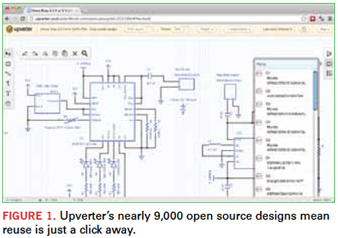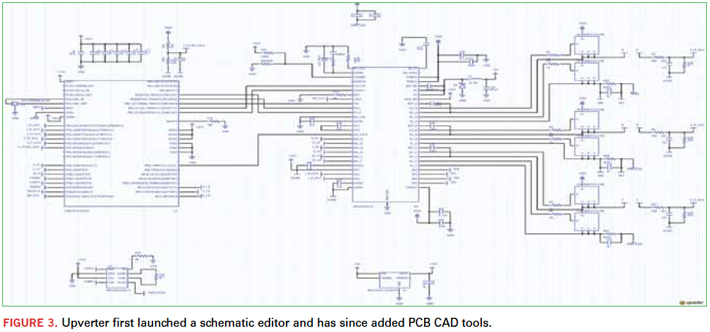Designing Hardware in the Cloud
Open source designs are becoming widely – and freely – available.
Multiple CAD and CAM companies’ tools from Altium to Ucamco to Cadence are now available via the cloud, albeit often through third parties.
There is, however, one company that is a dedicated cloud-based CAD provider: Upverter. The company, which was founded less than two years ago, aims to leverage online collaborative tools to perform printed circuit design using a web browser and, in doing so, drive what they call the first real technology transformation since Windows.
Upverter (upverter.com) relies on nothing more than the user’s preferred browser. (Upverter says it supports 17 different browsers on a regular basis, although old versions of Internet Explorer aren’t among them.) Because the primary browsers interoperate, teams can work on their designs without necessarily adopting an identical platform.
Brower-based design tools aren’t easy to build, of course, but using them is another story, the founders say. Among the advantages are free access to extraordinary technology, no need for in-house servers, no real maintenance or IT. Or, as cofounder and CEO Zak Homuth says, “You remove a bunch of complexity and get a lot of stuff for free.”
Upverter’s first product, which launched about 18 months ago, was a collaborative schematic editor. In November, they followed up with a major release that provides simulation, rapid prototyping, and involved a significant revamp to the schematic editor. At that time, the firm also released a new parts library.
And as it turns out, certain users, to date mostly hobbyists, can share in all that free stuff.
The firm has four basic pay models. The lowest price – free – comes with the limitation that all the designs, parts created or any other related IP are considered open source and available for public reuse. Upverter’s payoff is becoming notable: It boasts 8,000 to 9,000 available designs.

For those individuals who want some degree of privacy, the charge is a nominal $100 a year.
Team-based designers make up what Homuth calls the first “forced collaborative bucket.” This group pays about $100 a month for each user. Under this schedule, there’s no cap on the number of fulltime users, and designs can be sent to users outside the designated team who pay “by the hour” flex fees. There are no contracts, and fulltime users can be added or removed on a monthly basis.
The fourth level is the private cloud, designed for large corporations with perhaps thousands of users around the world. As Homuth describes it, this level offers higher level security, as the designs are not stored in the same place. Upverter also customizes the tools for this group.
“We’ve attempted to be able to charge the whole spectrum of people around the world and provide the services they need, but without limiting them as to what they can use,” explains Homuth. “There are guys in the basement who design motherboards. But teams by definition need collaboration.” As of late December, Upverter was approaching 10,000 users.
What those users are tuning in for is becoming more extensive. As Upverter’s first tool, the schematic editor is reasonably full featured, Homuth says. “We’re adding groups of nets and can display as a bus instead of as individual nets. We’re adding hierarchy modules (blocks) for designing a schematic within a schematic.”

Layouts have no limits: Designers can build an infinite number of layers. The tools can perform BGA breakouts, and differential pair and bus routing are being added. Much of these capabilities are a bit raw, Homuth admits, but are rapidly developing to full scale. Stackup and layer management features are available, but controlled impedance is not. “We are working with the Open Compute Project to get their server designs into Upverter to route DDR memory buses and control stackup, add prepregs, and do trace length matching of the whole bus. Those three features are really layout features and are on the cusp of being available,” he adds. Upverter lacks an autorouter at this time.
“The best way to describe our CAD is it’s like a machete: You can use it to do anything – you can use it to spread peanut butter or to cut down a tree. But it’s better for some things than others right now,” Homuth says.
The parts library contains 17,000 parts, all crowd-sourced and engineered by a user and subsequently edited by someone who wasn’t the creator. All users are notified of part updates, and have the option of accepting the update.
Users can export Gerbers, BoMs, and even an entire design as an open source file format using JSON (json.org). Another open source tool under development (https://github.com/upverter/schematic-file-converter) can convert any data into the CAD format of the user’s choice.
Much of the site’s appeal is the extensive IP available for reuse. There, Homuth says, one could find designs ranging from Arduino, Raspberry Pi and Internet of Things to distributed computing and sensor arrays. Shortly, all of SparkFun’s reference blocks will be available as well, and this month a few larger computer type designs will come online. These aren’t simply two layer boards with a handful of resistors. The average available design has hundreds of parts and maybe thousands of nets.
Security is handled the same as for anything stored in the cloud for credit cards or other personal information. Because the design never actually resides on the user’s PC, even an infected machine won’t comprise the data. “It’s just a jumble of data inside your web browser, and there’s a very good chance someone couldn’t reconstruct that even if they wanted to,” explains Homuth. “My anticipation is (hackers) wouldn’t know what they were looking at, and wouldn’t care.”
As any user knows, Java script can occasionally get in the way of browsers functioning properly. Upverter’s solution is to build on top of the same Google Java script program used for Gmail. That way, maintenance is Google’s problem.
Still, when Mozilla changed the way it implemented Canvas, the HTML element that can be used to draw graphics using scripting, Upverter quickly notified users of the affected version of Firefox about the glitch.
Asked how Upverter could keep its users up and running when it is reliant on third parties that might not share the CAD firm’s concerns, Homuth says it’s as simple as staying current on updates. “Because we are managing the data and compliance and migration, we are always up on the latest updates. You will never have the problem of an update conflicting with an old program. In exchange, you maybe have to update your web browser, but it’s a much more approachable problem for an engineer whose job is not maintaining IT systems and instead is designing PCBs.” For new designers or even veterans who don’t want to invest large sums in software, Upverter’s cloud-based CAD offers an airy solution.
[Ed.: To enlarge the figure, right-click on it, then click View Image, then left-click on the figure.)
Mike Buetow is editor in chief of PCD&F (pcdandf.com); This email address is being protected from spambots. You need JavaScript enabled to view it..




